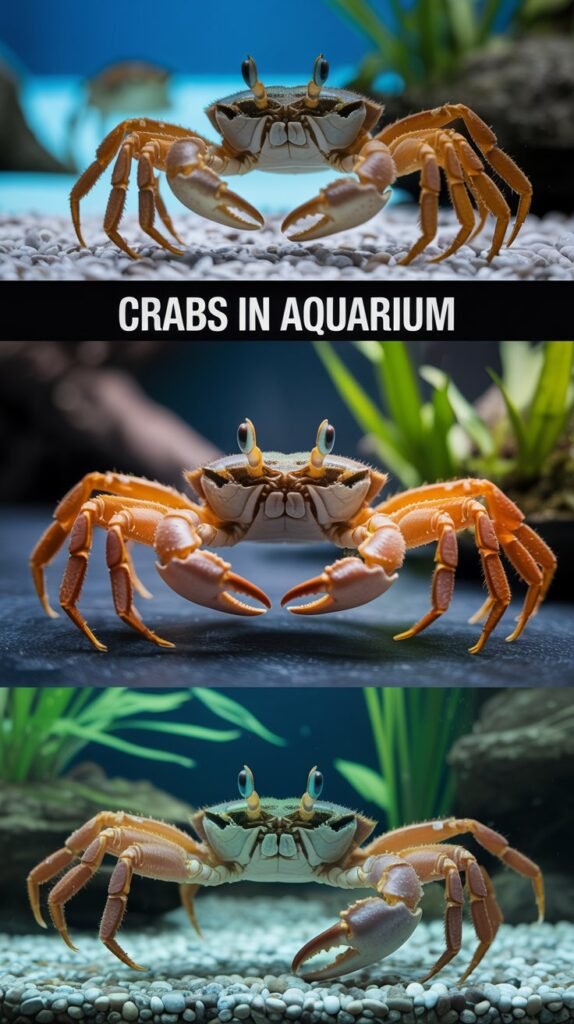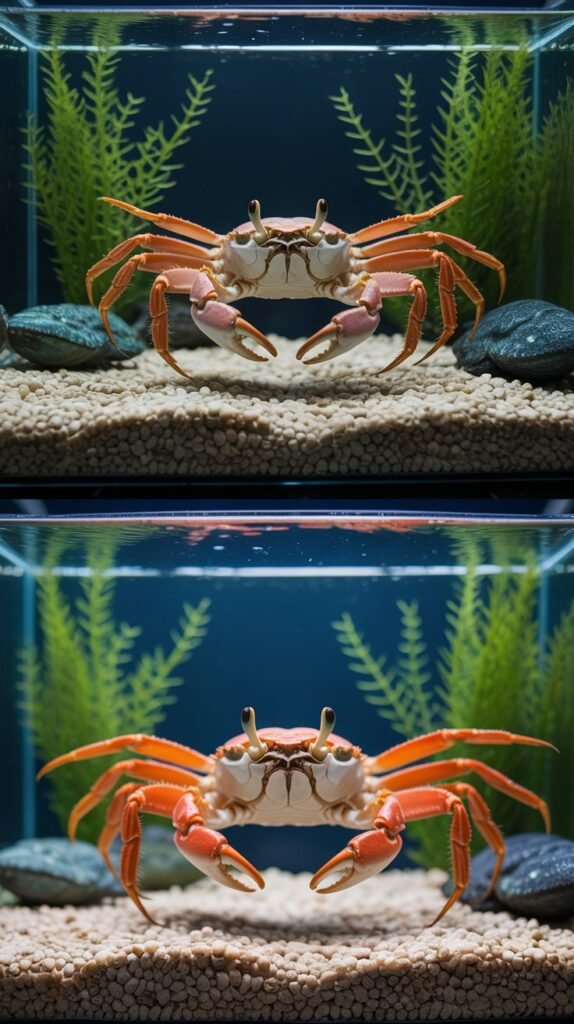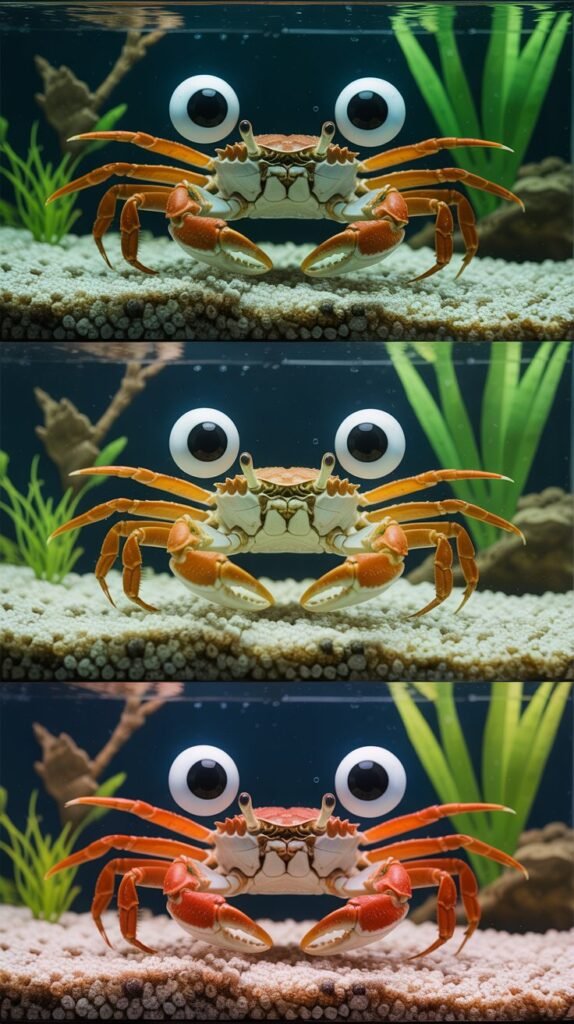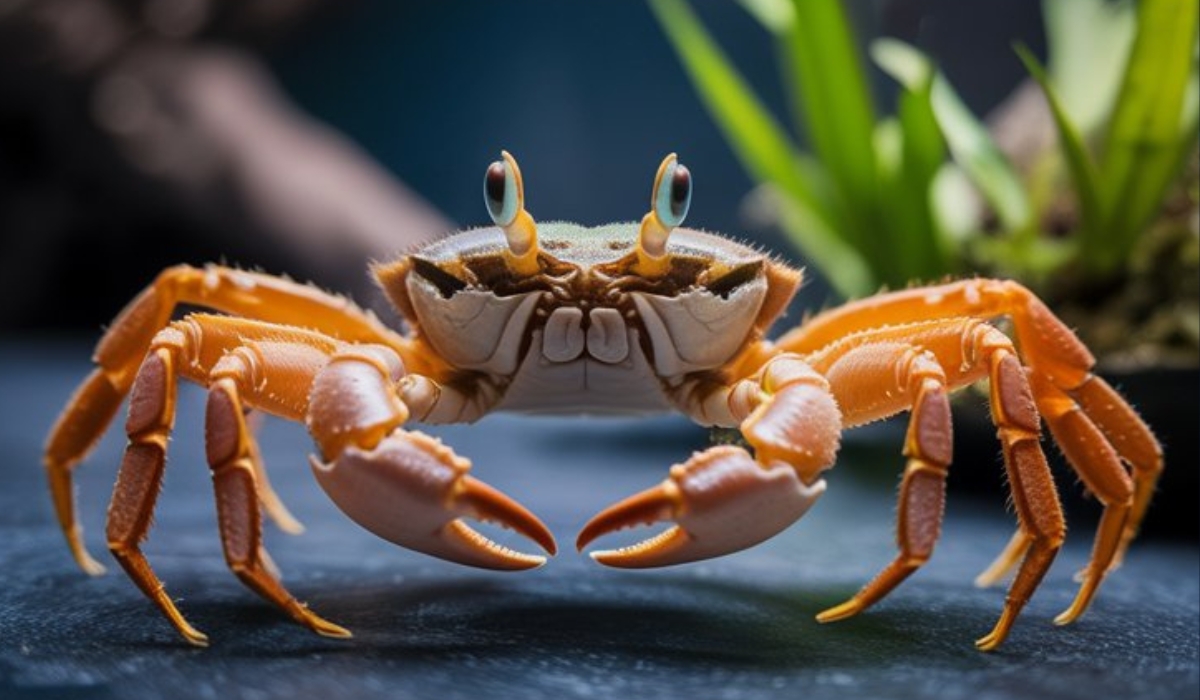Crabs are among the most fascinating creatures you can add to an aquarium. Their playful behavior, unique appearance, and scavenging habits make them both entertaining and functional tank mates. Whether you have a freshwater or saltwater setup, crabs in aquariums can contribute to the ecosystem’s balance while adding an exotic touch.
However, not all crabs are suitable for all tanks. Some species are peaceful scavengers, while others can be aggressive predators. To keep your aquarium thriving, it’s essential to understand their care requirements, compatibility, diet, and habitat setup.
This comprehensive guide covers everything you need to know about keeping crabs in aquariums, from choosing the right species to ensuring they stay healthy and active.
Why Keep Crabs in an Aquarium?
Crabs are not only captivating to watch but also serve practical functions in aquariums. Their natural scavenging behavior helps maintain cleanliness and balance. Below are some top reasons why aquarists add crabs to their tanks:

1. Natural Cleaners
Crabs act as the aquarium’s janitors, consuming leftover food, algae, detritus, and dead organisms. This helps prevent waste buildup and reduces water pollution.
2. Unique Aesthetics
With their bright colors, intricate shells, and quirky movements, crabs bring life and character to your aquarium. Species like the Red Claw Crab or Emerald Crab are particularly stunning additions.
3. Behavior and Interaction
Crabs display fascinating behavior, from digging and burrowing to climbing and scavenging. Watching their activities adds an engaging, natural element to your tank.
4. Ecosystem Balance
Crabs contribute to the tank’s biodiversity, complementing fish and other invertebrates. They can also help control nuisance algae or detritus.
Types of Aquarium Crabs
Aquarium crabs can be broadly categorized into freshwater, brackish, and saltwater types. Each has different care needs and compatibility levels.
1. Freshwater Crabs
Freshwater crabs thrive in fully freshwater environments but often prefer slightly brackish conditions. They are small, active, and ideal for aquarists who don’t maintain marine tanks.
Popular Freshwater Crab Species
- Thai Micro Crab (Limnopilos naiyanetri):
A true freshwater species, peaceful and fully aquatic. Perfect for nano tanks and shrimp communities. - Red Claw Crab (Perisesarma bidens):
Often sold as freshwater but requires brackish water. Known for its red claws and semi-terrestrial lifestyle. - Panther Crab (Parathelphusa pantherina):
Fully aquatic, aggressive, and known for its spotted shell. - Rainbow Land Crab (Cardisoma armatum):
Brightly colored but needs access to land and brackish conditions.
2. Brackish Water Crabs
Brackish crabs live in environments with a mix of fresh and saltwater. They require special care and water parameters to thrive.
Popular Brackish Crab Species
- Fiddler Crab (Uca spp.):
Famous for the male’s large claw used for communication. Needs access to both water and land. - Red Mangrove Crab:
Hardy and active, prefers semi-aquatic setups. Excellent scavenger.
3. Saltwater (Marine) Crabs
Marine crabs are commonly kept in reef aquariums. They are known for cleaning algae and leftover food from corals and rocks.
Popular Saltwater Crab Species
- Emerald Crab (Mithraculus sculptus):
Algae-eating crab that helps control bubble algae in reef tanks. - Sally Lightfoot Crab (Percnon gibbesi):
Agile and attractive, known for its long legs and energetic behavior. - Hermit Crab (Paguroidea):
Common in reef tanks; uses empty snail shells as protection. - Arrow Crab (Stenorhynchus seticornis):
Has a distinctive arrow-shaped body, good for controlling bristle worms.
Setting Up an Aquarium for Crab

Proper setup is critical to the survival and comfort of aquarium crabs. They need space to hide, climb, and molt safely.
s
1. Tank Size
- Small species (like Thai Micro Crabs): 5–10 gallons minimum.
- Medium crabs (Red Claw, Fiddler): 15–30 gallons.
- Large marine crabs (Emerald, Sally Lightfoot): 30 gallons or more.
2. Substrate
Use fine sand or smooth gravel, depending on species. Many crabs like to dig and bury themselves during molting, so provide a soft and deep substrate.
3. Hiding Spots
Crabs require hiding places to feel secure, especially during molting. Add:
- Rocks and driftwood
- PVC pipes or caves
- Live plants (for freshwater tanks)
- Coral and rock crevices (for saltwater tanks)
4. Water Parameters
Proper water conditions are essential for crab health. Parameters vary by type:
Freshwater Crab Parameters
- Temperature: 72°F–82°F (22°C–28°C)
- pH: 6.8–8.0
- Hardness: Moderate
- Ammonia/Nitrite: 0 ppm
Brackish Crab Parameters
- Salinity: 1.005–1.015
- pH: 7.5–8.3
- Temperature: 75°F–80°F
Saltwater Crab Parameters
- Salinity: 1.023–1.025
- pH: 8.1–8.4
- Temperature: 75°F–82°F
- Calcium: 400–450 ppm
5. Filtration and Aeration
Crabs produce waste, so efficient filtration is vital. Use a sponge or canister filter to keep water clean. Ensure good oxygenation through air stones or surface agitation.
6. Lighting
Crabs don’t require special lighting, but reef species benefit from full-spectrum lighting to support corals and algae growth. For land-access species, maintain a natural day-night cycle.
Feeding Crabs in Aquariums
Crabs are omnivorous scavengers that eat a wide range of foods. In aquariums, they’ll feed on leftover fish food, algae, and detritus—but supplemental feeding is still important.
Recommended Foods
- Algae wafers
- Sinking pellets
- Blanched vegetables (zucchini, spinach, peas)
- Shrimp pellets
- Frozen foods (brine shrimp, bloodworms, krill)
- Fish flakes (occasionally)
Feed once a day in small portions. Remove uneaten food to prevent pollution.
Behavior and Compatibility

Crabs are curious and territorial. Their compatibility depends on size, species, and tankmates.
1. Peaceful Species
Thai Micro Crabs and small hermit crabs are generally peaceful and can coexist with shrimp, snails, and small fish.
2. Semi-Aggressive Species
Red Claw and Panther Crabs can be territorial, especially with other males. Provide plenty of hiding spots and space.
3. Aggressive Species
Large marine crabs like Arrow Crabs or big hermits may prey on smaller tankmates or corals. Keep them with caution.
Compatible Tankmates
- Snails
- Shrimp (with caution)
- Gobies
- Blennies
- Tetras (for freshwater tanks)
- Small, non-aggressive fish
Avoid housing them with:
- Slow-moving fish
- Predatory species
- Other aggressive crabs
Molting: A Critical Stage in Crab Life
Crabs periodically molt—shedding their old exoskeleton to grow a new one. This is a vulnerable time when they hide and avoid contact.
Signs of Molting
- Reduced activity or hiding
- Dull coloration
- Refusal to eat
Post-Molt Care
- Do not disturb or handle the crab.
- Leave the old shell—it provides calcium.
- Ensure high humidity and stable water conditions.
Common Problems When Keeping Crabs
1. Poor Water Quality
Ammonia or nitrite buildup is fatal. Regular testing and partial water changes are crucial.
2. Lack of Land Access
Species like Fiddler and Red Claw Crabs need land areas to breathe and molt safely. Without it, they can drown.
3. Aggression
Overcrowding and limited hiding spaces cause fights. Maintain proper tank size and provide shelters.
4. Copper Contamination
Avoid using medications or water conditioners containing copper—it’s toxic to crabs and invertebrates.
5. Incorrect Salinity
Brackish and marine crabs need specific salinity levels. Fluctuations can lead to stress or death.
Breeding Crabs in Aquariums
Breeding aquarium crabs is challenging due to their complex life cycles. Most species release larvae that require different water conditions than adults.
- Freshwater crabs: Rarely breed in captivity; females carry eggs for several weeks.
- Brackish crabs: Eggs hatch into larvae that need specific salinity and microfoods.
- Marine crabs: Require advanced setups with plankton for larval feeding.
Most aquarists focus on maintaining healthy adults rather than breeding.
Cleaning and Maintenance Tips
- Perform weekly water changes (15–25%).
- Clean filters monthly but avoid replacing all media at once.
- Remove uneaten food promptly.
- Check ammonia, nitrite, and salinity regularly.
- Replace evaporated water with dechlorinated freshwater (not saltwater).
Best Crabs for Beginners
If you’re new to keeping crabs in aquariums, start with hardy and low-maintenance species:
- Thai Micro Crab: Peaceful, fully aquatic, easy to care for.
- Red Claw Crab: Active and colorful, suitable for semi-aquatic setups.
- Hermit Crab: Ideal for saltwater tanks, entertaining and helpful cleaner.
- Emerald Crab: Reef-safe and excellent for algae control.
Advantages and Disadvantages of Keeping Aquarium Crabs
Advantages
- Natural scavengers
- Visually striking and interesting behavior
- Help control algae
- Contribute to a balanced ecosystem
Disadvantages
- Some species are aggressive
- Require specific salinity or land areas
- Sensitive to poor water quality
- May attack small fish or shrimp
Conclusion
Keeping crabs in aquariums is a rewarding experience for both beginners and seasoned aquarists. Their vibrant personalities, cleaning habits, and fascinating behaviors make them unique additions to any tank.
Whether you prefer a freshwater crab like the Thai Micro Crab or a reef species like the Emerald Crab, success depends on understanding their natural habitat, maintaining stable water parameters, and ensuring a suitable environment.
Crabs bring a touch of the ocean’s charm into your aquarium—offering not just beauty, but balance and life.
FAQs About Crabs in Aquariums
1. Can crabs live in freshwater aquariums?
Yes, some crabs like Thai Micro Crabs and Panther Crabs can live in freshwater, but many sold as “freshwater” actually prefer brackish conditions.
2. Are crabs good for aquariums?
Absolutely! They clean up debris, uneaten food, and algae, helping maintain a cleaner tank.
3. Do crabs eat fish?
Some large or aggressive crabs may attack small or slow fish. Always research compatibility before adding them.
4. Can crabs live with shrimp?
Peaceful species like Thai Micro Crabs can coexist with shrimp, but aggressive ones like Red Claw Crabs may attack them.
5. How long do aquarium crabs live?
Most aquarium crabs live 2–5 years, depending on species and care quality.
6. Do crabs need land in aquariums?
Semi-aquatic crabs like Fiddler and Red Claw Crabs need access to land. Fully aquatic species like Thai Micro Crabs do not.
7. What do crabs eat in aquariums?
They eat algae, leftover food, detritus, and commercial crab pellets. Supplement with vegetables and protein-rich foods.
8. Why did my crab die suddenly?
Likely causes include poor water quality, copper exposure, or stress from molting or aggressive tankmates.
9. Can crabs climb out of the tank?
Yes! Many species are escape artists. Use a tight-fitting lid to prevent them from climbing out.
10. Are hermit crabs reef-safe?
Most hermit crabs are reef-safe and beneficial, but some may occasionally disturb corals or snails for shells.

